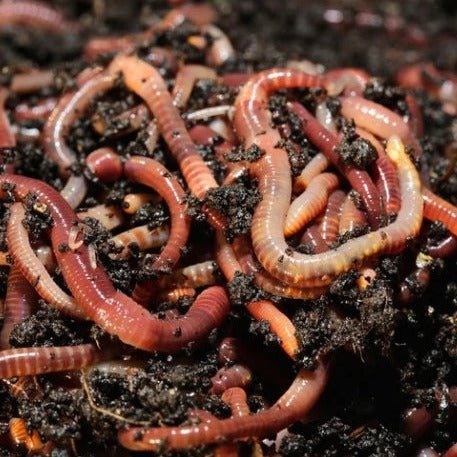Get Your Lawn in Top Shape with the Help of Lake Hickory Bait Yard Care Solutions
Get Your Lawn in Top Shape with the Help of Lake Hickory Bait Yard Care Solutions
Blog Article
Unlock the Secrets of Red Wigglers: Your Guide to Composting Success
The assimilation of red wigglers right into composting methods offers a substantial chance for boosting soil wellness and advertising sustainability. Comprehending their demands and behaviors is important for optimizing their capacity, from establishing up an appropriate worm bin to feeding them the appropriate products.

What Are Red Wigglers?
(Red Wiggler Express)Red wigglers, medically called Eisenia fetida, are a species of earthworm primarily made use of in composting because of their remarkable capacity to break down raw material efficiently. These worms are characterized by their reddish-brown pigmentation and a fractional body, normally gauging in between 3 to 4 inches in length. Unlike various other earthworm varieties, red wigglers thrive in abundant, natural settings, making them optimal for vermicomposting systems.
Native to The United States And copyright, they are commonly located in decomposing leaves and garden compost heaps, where they play a critical duty in nutrient recycling. Their adjustment to staying in a moist, cardiovascular setting enables them to eat big amounts of natural waste, simplifying right into nutrient-rich spreadings that enhance dirt wellness.
Red wigglers reproduce rapidly, with a single worm qualified of generating a number of cocoons each week, each containing multiple hatchlings. Understanding the biology and behavior of red wigglers is essential for maximizing their potential in composting applications.
Benefits of Utilizing Red Wigglers
Utilizing the power of red wigglers in composting offers numerous benefits that improve soil health and promote lasting waste monitoring. These exceptional organisms successfully damage down raw material, changing kitchen area scraps and backyard waste right into nutrient-rich vermicompost. This finished item is exceptionally helpful for plant development, as it enhances dirt structure, enhances wetness retention, and improves nutrient availability.

(Red Wiggler Express)Furthermore, the presence of red wigglers in your composting system can speed up the composting procedure, generating high-quality garden compost in a fraction of the time contrasted to traditional techniques. The castings generated by these worms are also brimming with helpful microbes that additionally improve the soil environment.
Establishing Your Worm Container
Creating an effective worm container is an uncomplicated procedure that can dramatically boost your composting initiatives. The initial step is picking a suitable container. Worm containers can be made from plastic storage containers, wooden boxes, or readily available worm bins. Make sure the container has ample water drainage and air flow holes to keep ideal dampness degrees and air flow.
Following, prepare the bedding material, which acts as the worms' habitat. A mix of shredded paper, cardboard, and coconut coir functions well, offering a comfortable atmosphere for the worms. Aim for a bed linen deepness of concerning 4-6 inches. Dampen the bedding lightly, guaranteeing it looks like a moist sponge without excess water merging at the bottom.

Feeding Your Red Wigglers
To guarantee the wellness and productivity of your red wigglers, it is important to offer them with a balanced diet regimen that fulfills their dietary needs. Red wigglers grow on a varied range of natural materials, which not only provide needed nutrients yet also advertise efficient composting.
Beginning by incorporating kitchen area scraps such as veggie peels, fruit cores, and coffee premises. Prevent citrus fruits, onions, and garlic, as these can be detrimental to worm wellness. Additionally, introduce shredded paper, cardboard, and dry fallen leaves to create a well-aerated environment.
Feeding frequency need to be kept an eye on; usually, worms can take in half their body weight in food weekly. It is essential to avoid overfeeding, as excess food can cause unpleasant smells and attract insects. A great practice is to add food in small amounts, enabling find more worms to refine it prior to presenting more.
Preserving wetness levels is likewise vital; the bed linen should be moist however not soggy. Be sure to consistently examine the temperature level and pH degrees of the bin to make certain an optimum environment for your red wigglers, eventually boosting their composting performance.
Harvesting and Utilizing Compost
A successful composting procedure with red wigglers finishes in the abundant, dark compost called vermicompost, which can significantly enhance dirt health and wellness and plant growth. Collecting this nutrient-dense material commonly takes place every three to six months, depending on the size of your system and the amount of natural issue being refined.
To collect, delicately different the compost from the worms and any undecomposed products. One efficient technique entails moving the contents of the bin to one side and including fresh bed linen and food to the void, motivating the worms to migrate. After a couple of days, the garden compost can be gathered from the opposite side.
It is essential to utilize vermicompost properly to maximize its benefits. By including vermicompost right into your gardening program, you not only reuse organic waste yet also create a thriving ecosystem that supports lasting gardening methods.
Conclusion
In summary, red wigglers function as phenomenal allies in composting initiatives, transforming natural waste right into nutrient-rich vermicompost (Red Wiggler Express). Their distinct organic features and reliable waste processing abilities add considerably to lasting horticulture practices. By recognizing the optimum problems for their environment, feeding demands, and garden compost harvesting strategies, garden enthusiasts can enhance dirt health and promote plant vitality. Accepting vermicomposting not just lowers landfill waste yet also fosters an extra eco accountable approach to gardening and source administration.
Report this page